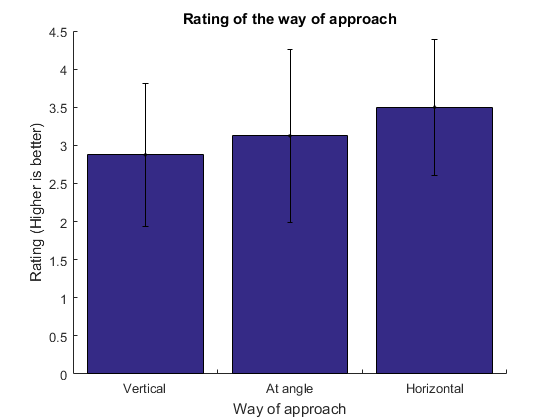PRE2015 3 Groep2 week6
Further testing
NOTE: Experiments in random order.
Due to limited battery time, a small adjustment has been made to the experiment to increase productivity. Instead of testing with only one test subject at the time, two people will be standing next to each other as the drone approaches them. Because of the accuracy of the drone, which is about 0.5 meter, both test subjects should feel as they are being approached by the drone. The test subjects have approved it and indicate that because the full focus is on the drone, it does not influence the results. Afterwards both test subjects are questioned separately so their opinions will not influence each other.
Experiment 2
Results A
| Experiment | Very bad | Bad | Neutral | Good | Very good |
|---|---|---|---|---|---|
| 1A | X | ||||
| 2A | X | ||||
| 3A | X | ||||
| 4A | X | ||||
| 5A | X |
Results B
| Experiment | Very bad | Bad | Neutral | Good | Very good |
|---|---|---|---|---|---|
| 1B | X | ||||
| 2B | X | ||||
| 3B | X | ||||
| 4B | X | ||||
| 5B | X |
Results C
| Experiment | Very bad | Bad | Neutral | Good | Very good |
|---|---|---|---|---|---|
| 1C | X | ||||
| 2C | X | ||||
| 3C | X | ||||
| 4C | X | ||||
| 5C | X |
Analyzing results

T-test
A T-test gives the possibility to decide if an hypotheses needs to be rejected or not. (Theory will follow) [1]
Shown in the table bellow are the p-values of the different ways of approaching. Values which are rejected by the t-test (one-tailed 95% coincidence interval, α = 0.05) are marked with an 'X'.
| Rating | Vertical | At an angle | Horizontal |
|---|---|---|---|
| Very bad | 0,051606 | X | X |
| Bad | 0,47662 | X | X |
| Neutral | 0,30456 | X | 0,30456 |
| Good | X | 0,3739 | 0,47662 |
| Very good | X | X | 0,051606 |
Looking at the the p-values approaching the user with an horizontal path seems the best.
References
- ↑ Diez, D.M. Barr, C.D. Çetinkaya-Rundel, M. (2012) OpenIntro Statistics. Second Edition